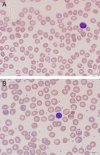Erythrocyte pyruvate kinase deficiency: 2015 status report
- PMID: 26087744
- PMCID: PMC5053227
- DOI: 10.1002/ajh.24088
Erythrocyte pyruvate kinase deficiency: 2015 status report
Abstract
Over the last several decades, our understanding of the genetic variation, pathophysiology, and complications of the hemolytic anemia associated with red cell pyruvate kinase deficiency (PKD) has expanded. Nonetheless, there remain significant gaps in our knowledge with regard to clinical care and monitoring. Treatment remains supportive with phototherapy and/or exchange transfusion in the newborn period, regular or intermittent red cell transfusions in children and adults, and splenectomy to decrease transfusion requirements and/or anemia related symptoms. In this article, we review the clinical diversity of PKD, the current standard of treatment and for supportive care, the complications observed, and future treatment directions.
© 2015 Wiley Periodicals, Inc.
Figures


References
-
- Nathan DG, Oski FA, Miller DR, Gardner FH. Life‐span and organ sequestration of the red cells in pyruvate kinase deficiency. N Engl J Med 1968;278:73–81. - PubMed
-
- Warang P, Kedar P, Ghosh K, Colah R. Molecular and clinical heterogeneity in pyruvate kinase deficiency in India. Blood Cells Mol Dis 2013;51:133–137. - PubMed
-
- Pissard S, Max‐Audit, I , Skopinski L, et al. Pyruvate kinase deficiency in France: A 3‐year study reveals 27 new mutations. Br J Haematol 2006;133:683–689. - PubMed
-
- Zanella A, Bianchi P. Red cell pyruvate kinase deficiency: From genetics to clinical manifestations. Baillieres Best Pract Res Clin Haematol 2000;13:57–81. - PubMed
Publication types
MeSH terms
Substances
Supplementary concepts
LinkOut - more resources
Full Text Sources
Other Literature Sources
